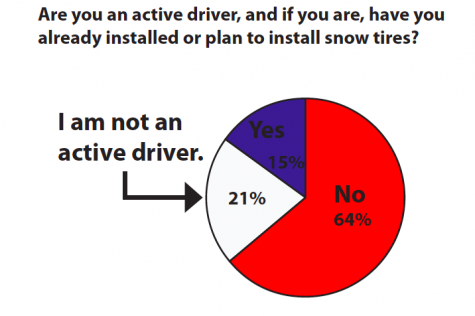Snow Tires: Are They A Worthy Investment?

Now that winter has arrived, that usually means colder temperatures and more snow, and while the first is easier to handle with the proper layers, the latter can be more challenging, especially for new drivers. Snow can make New England roads downright treacherous, so a good rule of thumb for new drivers is to always be prepared for the worst.
Preparing for the worst snowy conditions has never been easier due to a great current selection of snow-fighting technology, including snow chains, tire socks and more. However, without a doubt, the most recognized form of protection for winter driving is snow tires.
Most recognized does not necessarily translate to popular, though, according to local standards. In a survey of 100 upperclass students, only about 19 percent of those who claimed they were active drivers (15 out of 79 active drivers) said they had or were planning to buy snow tires.

Apparently, this is not an unusual trend, at least according to John Incardone (Pictured above), one of the co-owners of Main Street Service Center in Hopkinton.
He said the statistic is “pretty much the norm right now” for that aspect of the business.
Some student drivers also said that they were planning to rely on other means for combating the snow and ice, including all-season tires instead of snow tires and also four-wheel drive.
A main reason for this aversion from snow tires is likely the cost.
“Depending on the size of the tire and the type of the tire, $800,” Incardone said about the average price for a full set of snow tires.
For some, that may not be exactly cheap, which is why Incardone described snow tires as “nice-to-have versus need-to-have.”
However, others say largely the opposite.
One advocate for snow tires is George Mansour, who is a manager at Eli’s Service Station in Arlington, Massachusetts. He is a self-proclaimed “master” technician and a certified engine specialist, and he has been using snow tires for a while.
“Every season, I switch to snows that I keep in my basement at home,” Mansour said. “And the snows that I purchase generally will last about four or even five seasons.”
Maintaining that schedule has apparently yielded its own benefits for Mansour, who said that his regular tires last longer because they sit in storage.
However, the main draw of snow tires will always be their performance in the snow, and the secret behind that has to do with differences in traction.
“Snow tires generally are made of softer compounds and they’re gummy on the ground, so they stick on ice and snow, and they also channel the snow away from themselves when they’re rolling over snow,” Mansour said.
All-season tires do not match up in that regard, a point Incardone agreed with.
“The disadvantage to running this (type of) tire in the snow is the design is not consistent with dispersing snow as you’re driving down the road,” Incardone said. “It’s designed for traction in the dry and wet weather and in some light snow.”
Mansour also repeatedly referred to all-season tires as “mediocre” in regards to their performance in the rain, the dry, and the snow, but soon afterward clarified his opinion.
“They’re good enough for the dry. In the wet, they’re decent, but they truly fall off a cliff in the snow,” Mansour said.
Mansour has also seen this difference first hand in his experience as a driver.
“One example I could tell you is I was going uphill in Boston, and amazingly, it was such a slippery road, maybe because of the lack of salt and the lack of preparation on that particular road. This may have been over 10 years ago–and four or five cars in front of me were stuck sliding backwards,” he said. “I basically went around that whole mess: It was a double line and there were no cars on the other side of the road, so I just passed that whole mess and just went right up the hill with my snow tires.”
Perhaps snow tires should be considered a bit more as an option because of these reasons. They may be more valuable than given credit for in situations where the winter elements are at their worst.
For those who are still considering looking into snow tires, there are some more important details to know about.
For starters, in the 100-student survey, the most commonly mentioned tire was the Michelin brand, followed by other popular household names like Goodyear and Bridgestone, which makes sense given the evidence.
“There are many different manufacturers who make snow tires, and I think Michelin is a very popular name,” Incardone said. “A lot of people are familiar with the name Michelin because of advertising campaigns and so on. Michelin is the best of the best, but there are many other companies that do make snow tires that are quality and safe tires to use.”
Consumer Reports also rated the top five best snow tires in the following descending order: Michelin, Pirelli, Continental, Nokian, and Goodyear.
All of these may be viable options, but for those wary of high costs, there are also cheaper options available.
“There are some Chinese brand tires that are kind of offshoots of other tires or just don’t have so much technology in them, but you can get them for a lot better of a price,” George Mansour said. “It could be half the price of a Bridgestone, and for somebody looking to spend less money, you could pick those up and they’d do a pretty good job as well. They’re not really designed for handling or anything you’re looking for in an all-season tire, but it would sure do the job safely as well because they’re all DOT-approved, the Chinese tires.”
While not the same quality as the mainstream snow tires, they would at least handle the winter conditions better than regular tires would. Other than that, other moves could also made to cut the costs of a snow tire investment and still get some good results.
While Mansour recommends four snow tires, he also said you can put two on the front of a front-wheel drive car with “relative safety.”
In turn, he also recommends to refrain from doing the same with the back of a rear-wheel drive car.
“If you put snow tires only on the back because you’re driving a BMW rear-wheel-drive or something, the back of the car is going to feel like it’s disconnected from the front, and it’s going to fishtail all over the place,” Mansour said.
After that, the only other preparation people can make is to change their driving style in a way that will keep them safe.
“I just pedal the gas a little bit more,” Mansour said. “I’m easy on take-offs, and I plan a lot of time–more than normal–for braking, and I leave a good space between myself and the car in front of me.”
Snow tires, as well as chains and other alternatives for combating the winter weather will only be as good as the person behind the wheel. It would do well to develop these habits sooner rather than later, before the brunt of winter hits.
Also: Here is the link to a demonstration video with Main Street Service Center’s John Incardone explaining more about the differences in traction between snow tires and regular/all-season tires.




